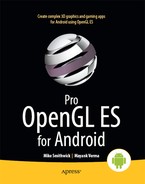Book Description
In Pro OpenGL ES for Android, you'll find out how to harness the full power of OpenGL ES, and design your own 3D applications by building a fully-functional 3D solar system model using Open GL ES!
OpenGL has set the standard for 3D computer graphics, and is an essential aspect of Android development. This book offers everything you need to know, from basic mathematical concepts to advanced coding techniques. You'll learn by building a fascinating 3D solar system simulator!
After introducing Open GL ES, Pro OpenGL ES for Android explains the basics of 3D math and then orients you to the native Android 3D libraries you'll be using in your own 3D games and the solar system project you'll build using this book. Through the solar system example project, you'll learn how to incorporate a variety of graphic and animation techniques into your applications. You will also discover how the full spectrum of 3D development that awaits, with topics such as lighting, texture-mapping, modeling, shaders, blending modes, and several more advanced concepts.
By the time you finish Pro OpenGL ES for Android, you'll have learned all the skills you'll need to build your own incredible 3D applications, based on one of the most powerful 3D libraries available.
What you'll learn
The basics of 3D mathematics, and how they are applied in the OpenGL library
How to design and build your 3D worlds
To create 2D interfaces within the 3D world
To develop animation and 3D movement
How to implement 3D shading, coloring, and texturing
The differences between OpenGL and other 3D toolkits
To build a fully-functional 3D solar system simulator using OpenGL ES
Who this book is for
Experienced Android programmers who want to enter the 3D world of OpenGL ES programming.
Table of Contents
- Title
- Dedication
- Contents at a Glance
- Contents
- About the Authors
- About the Technical Reviewer
- Acknowledgments
- Introduction
- Chapter 1: Computer Graphics: From Then to Now
- Chapter 2: All That Math Jazz
- Chapter 3: From 2D to 3D: Adding One Extra Dimension
- Chapter 4: Turning On the Lights
- Chapter 5: Textures
- Chapter 6: Will It Blend?
- Chapter 7: Well-Rendered Miscellany
- Chapter 8: Putting It All Together
- Chapter 9: Performance 'n' Stuff
- Chapter 10: OpenGL ES 2, Shaders, and…
- Index
